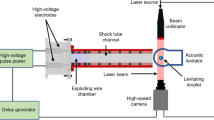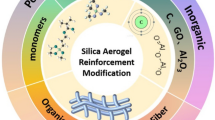Abstract
Shear thickening fluids (STFs) have gained attention for their capacity to increase viscosity with higher shear rates, rendering them solid-like under high-impact conditions. This reversibility renders STFs valuable for diverse applications, particularly in defense systems. Preceding our study, mechanical hurdles, such as aggregation and blending issues, hindered efficient utilization. Our research presents an innovative method for STF synthesis using polyethylene glycol and SiO2 nanoparticles. Significantly, we employed a hot plate and oil bath to remove ethanol from the STF, a distinctive aspect of our approach. We also systematically explored the impact of temperature and the dispersion weight fraction of fumed silica nanoparticles on crucial rheological parameters, encompassing viscosity, shear rate, storage modulus (G′), and loss modulus (G″). As temperatures increased, the critical shear rate also rose, while viscosity decreased. Additionally, we observed a significant enhancement in thickening behavior with higher SiO2 concentrations in STFs. For instance, the peak viscosity of 15 wt% STF decreased by approximately 69.47% from 20 to 40 °C and by approximately 89.92% from 20 to 60 °C. This study highlights the unique rheological properties of STFs.









Similar content being viewed by others
Availability of data and materials
Data and materials will be available upon request.
References
Boersma WH, Laven J, Stein HN (1990) Shear thickening (dilatancy) in concentrated dispersions. AIChE J 36:321–332
Lee YS, Wagner NJ (2006) Rheological properties and small-angle neutron-scattering of a shear thickening, nanoparticle dispersion at high shear rates. Ind Eng Chem Res 45:7015–7024
Wagner NJ, Brady JF (2009) Shear thickening in colloidal dispersions. Phys Today 62:27–32
Lee YS, Wagner NJ (2003) Dynamic properties of shear thickening colloidal suspensions. Rheol Acta 42:199–208
Hasannezhad, H, Yazdani M (2022) Investigate the dynamic compressive (cushioning) response of 3D GFRP composites when the STF matrix base material is modified PEG, J Mol Liq 366:120304. https://doi.org/10.1016/j.molliq.2022.120304
Yu M, Qiao X, Dong X et al (2018) Effect of particle modification on the shear thickening behaviors of the suspensions of silica nanoparticles in PEG. Colloid Polym Sci 296:1767–1776
Shende T, Joekar-Niasar V, Babaei M (2021) An empirical equation for shear viscosity of shear thickening fluids 325:115220–115220. https://doi.org/10.1016/j.molliq.2020.115220
Islam E, Kaur G, Bhattacharjee D et al (2018) Effect of cellulose beads on shear-thickening behavior in concentrated polymer dispersions. Colloid Polym Sci 296:883–893
Mohsen Jeddi M, Yazdani Hossein Hasannezhad (2021) Experimental study on puncture resistance of 2D and 3D glass fabrics reinforced with shear thickening fluid (STF). https://doi.org/10.22060/ajme.2021.19920.5973
Guo F, Xu Z, Gu J (2023) Effects of nano-fumed silica and carbonyl iron powder of different particle sizes on the rheological properties of shear thickening fluids. Colloid Polym Sci 301:539–555
Arun M, Sivagami SM, Raja Vijay T, Vignesh G (2023) Experimental investigation on energy and exergy analysis of solar water heating system using zinc oxide-based Nanofluid. Arab J Sci Eng 48(3):3977–3988
Munusamy A, Barik D, Sharma P, Medhi BJ, Bora BJ (2023) Performance analysis of parabolic type solar water heater by using copper-dimpled tube with aluminum coating. Environ Sci Pollut Res 9:1–6
Barik D, Saeed MA, Ramachandran T (2022) Experimental and computational analysis of aluminum-coated dimple and plain tubes in solar water heater system. Energies 16(1):295
Arun M, Barik D, Sridhar KP (2022) Experimental and CFD analysis of dimple tube parabolic trough solar collector (PTSC) with TiO2 nanofluids. J Therm Anal Calorim 8:1–8
Arun M, Barik D, Sridhar KP, Dennison MS (2022) Thermal performance of a dimpled tube parabolic trough solar collector (PTSC) with SiO2 nanofluid. Int J Photoenergy 28:2022
Arun M, Barik D, Sridhar KP, Vignesh G (2022) Performance analysis of solar water heater using Al 2 O 3 nanoparticle with plain-dimple tube design. Exp Tech 1–4
Arun M, Barik D, Sridhar KP, Vignesh G (2021) Experimental and CFD analysis of artificial dimples surface roughness by using application of domestic solar water heater. In Intelligent Manufacturing and Energy Sustainability: Proceedings of ICIMES 2020 285–298. Springer Singapore.
Arun M, Barik D, Sridhar KP, Vignesh G (2021) Experimental and CFD analysis of plain and dimples tube at application of solar water heater. Materials Today: Proceedings 1(42):804–809
Arun M, Barik D, Sridhar KP, Vignesh G (2021) Experimental and CFD analysis of copper plain and dimples tube at application of solar water heater. Materials Today: Proceedings 1(42):410–415
Hasan-nezhad H, Yazdani M, Jeddi M (2022) High- and low-velocity impact experiments on treated STF/3D glass fabrics, Thin-Walled Struct 171:108720. https://doi.org/10.1016/j.tws.2021.108720
Bing Liu, Chengbin Du, Huaxia Deng, Yankai Fu, Fei Guo, Ling Song, Xinglong Gong (2022) Study on the shear thickening mechanism of multifunctional shear thickening gel and its energy dissipation under impact load. Polymer 247:124800. https://doi.org/10.1016/j.polymer.2022.124800
Jeddi M, Yazdani M, Hasan-nezhad H (2021) Energy absorption characteristics of aluminum sandwich panels with Shear Thickening Fluid (STF) filled 3D fabric cores under dynamic loading conditions. Thin-Walled Struct 168:108254. https://doi.org/10.1016/j.tws.2021.108254
Hasan-nezhad H, Yazdani M, Salami-Kalajahi M, Jeddi M (2020) Mechanical behavior of 3D GFRP composite with pure and treated shear thickening fluid matrix subject to quasi-static puncture and shear impact loading. J Compos Mater 54(26):3933–3948
Zhang X, Li W, Gong X (2010)Thixotropy of MR shear-thickening fluids. Smart Mater Struct 19:125012
Hasan-nezhad H, Yazdani M, Akbari A, Salami-Kalajahi M, Kalhori M-R (2022) Study the effects of PEG modification methods on the resistance of 3D E-glass woven-STF composites at quasi-static and low-velocity impact loads. J Mol Liq 362:119781
Gürgen S, Li W, Kus¸ han MC (2016) The rheology of shear thickening fluids with various ceramic particle additives. Mater Des 104:312–9
Hasanzadeh M, Mottaghitalab V, Babaei H, Rezaei M (2016) The influence of carbon nanotubes on quasi-static puncture resistance and yarn pull-out behavior of shear-thickening fluids (STFs) impregnated woven fabrics. Compos PartAppl Sci Manuf 88:263–271
Petel OE, Ouellet S, Loiseau J, Frost DL, Higgins AJ (2015) A comparison of the ballistic performance of shear thickening fluids based on particle strength and volume fraction. Int J Impact Eng 85:83–96
Tan VBC, Tay TE, Teo WK, Solids J (2005) Struct 42:1561–1576
Gómez-Merino AI, Jiménez-Galea JJ, Rubio-Hernández FJ, Arjona-Escudero JL, Santos-Ráez IM (2020) Heat transfer and rheological behavior of fumed silica nanofluids. Processes 8:1535. https://doi.org/10.3390/pr8121535
Abdi Esmaeil, Ata Khabaz-Aghdam, Hosein Hasan-nezhad, Bashir Behjat EAS, Marques, Yongming Yang, da Silva LFM (2022) The effect of graphene and graphene oxide on defective single lap adhesively bonded joints. J Compos Mater 56(17):2665–2675
Jiang WQ, Ye F, He QY, Gong XL, Feng JB, Lu L, Xuan SH (2014) J Colloid Interface Sci 413:8–16
Jiang T, Zukoski CF (2012) Macromolecules 45:9791–9803
Raghavan SR, Khan SA (1997) J Colloid Interface Sci 185:57–67
Raghavan SR, Walls HJ, Khan SA (2000) Langmuir 16:7920–7930
Kamibayashi M, Ogura H, Otsubo Y (2008) J Colloid Interface Sci 321:294–301
Gun’Ko VM, Mironyuk IF, Zarko VI, Voronin EF, Turov VV, Pakhlov EM, Goncharuk EV et al. (2005) Morphology and surface properties of fumed silicas. J Colloid Interface Sci 289(2):427–445
Haris A, Lee HP, Tan VB (2018) An experimental study on shock wave mitigation capability of polyurea and shear thickening fluid-based suspension pads. Def Technol 14(1):12–18
Chauhan RR, Dullens RPA, Velikov KP, Aarts DGAL (2017) Exploring concentration, surface area, and surface chemistry effects of colloidal aggregates on fat crystal networks. RSC Adv 7:28780–28787
Aliabadian E, Sadeghi S, Kamkar M, Chen Z, Sundararaj U (2018) Rheology of fumed silica nanoparticles/partially hydrolyzed polyacrylamide aqueous solutions under small and large amplitude oscillatory shear deformations, J Rheol 62:1197-1216
Kang TJ, Hong KH, Yoo MR (2010) Fiber Polym 11:719–724
Bossis G, Brady JF (1989) J Chem Phys 91:1866–1874
Suh YJ, Ullmann M, Friedlander SK, Park KY (2001) J Phys Chem B 105:11796–11799
Khan SA, Zoeller NJ (1993) J Rheol 37:1225–1235
Srinivasa R, Raghavan Walls HJ, Saad Khan* A (2000) Rheology of silica dispersions in organic liquids: new evidence for solvation forces dictated by hydrogen bonding, Langmuir 16:7920–7930
Liu X-Q, Bao R-Y, Wu X-J, Yang W, Xie B-H, Yang M-B (2015) Temperature induced gelation transition of a fumed silica/PEG shear thickening fluid. RSC Adv 5:18367–18374. https://doi.org/10.1039/c4ra16261g
Kyu H, Heun KS, Hyun AK, Jong LS (2002) Large amplitude oscillatory shear as a way to classify the complex fluids. J Nonnewton Fluid Mech 107:51–65
Huang Qiang Gu, Mingyuan Sun Kang, Yanping J (2002) Effect of pretreatment on rheological properties of silicon carbide aqueous suspension. Ceram Int 28: 747–754
Shih W-H, Shih WY, Kim S-I, Liu J, Aksay IA (1990) Scaling behavior of the elastic properties of colloidal gels. Phys Rev A 42:4772
Richard Buscall P, Mills DA, Goodwin JW, Lawson DW (1988) Scaling behavior of the rheology of aggregate networks formed from colloidal particles. J Chem Soc Faraday Trans 1(84):4249–4260.
Author information
Authors and Affiliations
Contributions
Sajjad Astaraki: Preparing samples and testing, Methodology, writing – original draft, investigation. Ehsan Zamani: Supervision, writing – review & editing, project administration. Majid Moghadam: Conceptualization, validation. Mohammad Hossein Pol: Formal analysis, review. Hosein Hasannezhad: Review & editing.
Corresponding author
Ethics declarations
Ethics approval and consent to participate
Not applicable.
Competing interests
The authors declare no competing interests.
Additional information
Publisher's Note
Springer Nature remains neutral with regard to jurisdictional claims in published maps and institutional affiliations.
Rights and permissions
Springer Nature or its licensor (e.g. a society or other partner) holds exclusive rights to this article under a publishing agreement with the author(s) or other rightsholder(s); author self-archiving of the accepted manuscript version of this article is solely governed by the terms of such publishing agreement and applicable law.
About this article
Cite this article
Astaraki, S., Zamani, E., Moghadam, M. et al. Investigating the effect of temperature, angular frequency, and strain on the rheological properties of shear thickening fluid (STF) with different weight fractions of fumed silica. Colloid Polym Sci 302, 1–11 (2024). https://doi.org/10.1007/s00396-023-05173-3
Received:
Revised:
Accepted:
Published:
Issue Date:
DOI: https://doi.org/10.1007/s00396-023-05173-3




